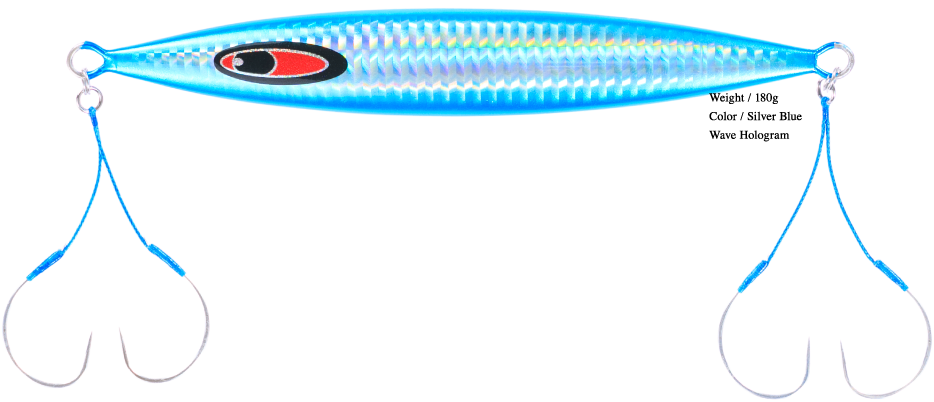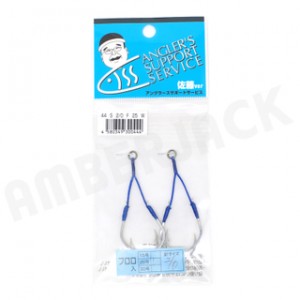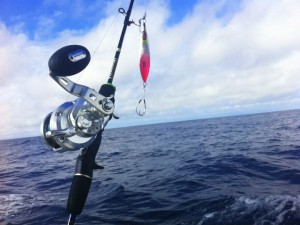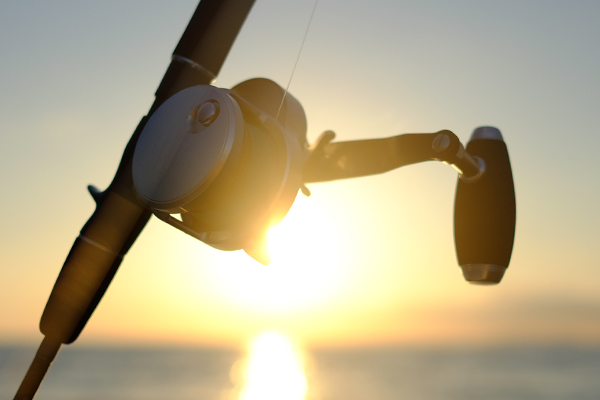Hooks for Slow Pitch Jigging
Sato’s Double Hooks
This is the pre-rigged double hook from Anglers Support Service (ASS), just as how Sato Sensei makes then with Pike hooks from Decoy with PE20 with Fluoro core. Available at 1026 yen.
ASS Double Hooks
This is the economy version by ASS, available at 598 yen. The hooks are ASS original with the hole in the eye. The assist line is knotted to the hooks, not a PR knot like the Sato’s Double Hooks.
Angler’s Support Service has been out of business. These products are no longer available.
Sato Sensei came up with this technique of slow pitch jigging in order to get contacts in the time of the day when the fish is slow and no one else is getting fish. Everything had to be fine tuned. But on the other hand, he wanted to be ready for a big game with the remarkably light tackle he uses. He’s examined every tiny little details for finesse and power.
And that is how he constantly catches the most fish, in a good day or a bad day. He says 90% of the difference is in preparation.
SPJ uses a double hook system.
Double, not single, because we want to use the light wired hooks that can penetrate easy. Because a lot of times fish bites when the jig is swimming or falling on its own. That’s the time the line doesn’t have tension and we don’t know the contact. We want the good penetration so that the jig can hook the fish without us striking. Also the heavy wire would interfere the jig’s natural movements.
The assist line has fluoro line running through PE braided.
Slow pitch utilizes a lot of small actions and falling actions. The jig moves up and down a lot. The firmness of the fluoro cored PE assist line keeps the hooks from tangling with the leader. Yet, it’s flexible enough to be swallowed by fish easily.
We put on a double hook on the head and also on the tail.
Fish always try to bite on the head of the prey. The head is not where the humans paint the eye on the jig. To fish, it’s the front of the movement. When the jig is uplifting, fish bites on the head of the jig. When the jig is falling, fish bites on the tail of the jig.
Slow pitch Jigging Principles
Sato Sensei’s principles about the line system are like this;
- The light PE that doesn’t stretch gives more control of the jig.
- Use less metal parts in your system as possible.
- Use lighter line and less metals when you want contacts.
- Always use the smallest and the toughest knots.
- It improves the jig’s falling performances when you have hooks on the flat side of the jig.
- Hook setting does change the jig movements. See it for yourself at the shallow water.
The double hooks came out of these ideas. The hooks are positioned as pointing inward to each other. When one hook catches the fish, the other also catches the fish too, hopefully one on inside the lip and one on the outside. When you hook a fish like that you’ll never unhook it, because the physics work in a way that the fish fight away only to result in hooking deeper and completely. Even when you don’t hook like that, 2 hooks assist each other, sharing the burden of fish fight. And we have 4 hooks total. It means you can use light-weight fine hooks which are easier to be swallowed. Once one hook finds the fish, the others will find some places to hook, eventually “hugging” the fish.
But the problem I see is that you can hardly release your catch. A lot of times fish get deep wounds. You need to take home and eat it.
Hope the information helps you! Good luck!
Tags In
Related Posts
28 Comments
Leave a Reply Cancel reply
Categories
- 1. SPJ (57)
- 1-1. Principles (9)
- 1-2. Techniques (11)
- 1-3. Setup (17)
- 1-4. FAQ (19)
- 1-5. Tackles (3)
- 1-6. Video Gallery (2)
- 2. Other Offshore Games (5)
- 3. Fishing Report (105)
- 3-1. Totos (25)
- 3-2. Readers (72)
- 4. Fish Cooking (19)
- 4-1. Iki-Jime (3)
- 4-2. The Art of Sashimi (5)
- 4-3. Recipe (7)
- 4-4. Seasoning (3)
- 5. Fishing Charter (6)
- Fish (12)











Hi Totos,
On my recent trip to Japan, I saw these Anglers Support Service products in the stores, but didn’t get to buy any of it since I can make the double assist hook myself ( after watching Sato Sensei DVDs, of cause!). I just bought a bunch of Decoy AS-03P hooks which are hard to find here. There are several DIY kits for those who are interested available in those stores too.
Best regards,
Kitidas P.
Thank you Kitidas. I forgot this part. I just added the article.
I hope you are enjoying the assembly. Because I gave up the bobbin work and stay with the easy know. Good luck!!!
I cannot make the knot to the solid ring on the economy version….aaaaarrrrrrgggh!
Hi Daz.
Send me a message and tell me what the problem is.
Hi Totos
Just wondering what brand of split ring pliers you choose to use for attaching your hooks?
The hots rings, although strong, are small and my pliers are a bit clumsy- maybe I’m clumsy.
Thanks
Daz
Hi Daz.

It’s true that slow pitch pursues such finesse that even the rings are so small.
I used to use a bigger prier but I changed it for the same reason you have now. I now use a prier from Maria.
But any prier will do only if it’s small enough. it’s important that you can work smoothly because we often change jigs and hooks in a hurry on the boat.
I also bring a little prier from Shimano which I normally use in my light shore game.

This is very popular among our fellow anglers.
totos,
can you show the picture/illustrations of a complete rigging
as
rear hooks(brand/no)+solid ring (brand/no)+ split ring(brand/no)+jig(brand/weight/colour)+split ring + solid ring + knot + leader(length) + knot + mainline (length) + rod (PE/brand/) + reel(brand/size)
OK Hazadin. I will work on it.
Hi Totos, may I know A.S.S original hook No.22 are usually what sizes? – http://global.rakuten.com/en/store/amberjack/item/fg-as-fook22-50/
I usually use Owner Cultive SJ-38 Stinger size 5/0.
Would they be similar? I usually use 170gsm to 210gsm jigs.
Thanks!
Will this help?
http://anglers-secrets.com/v2020/product/02hook/a-s-s-standard-anaaki-hook/
It’s a good size if as double hook for 200g jig.
Heloo totos question about this Decoy DJ-88 Twin Pike Assist Hooks Size 2/0 (6127) ?what is you comment about this asisst hook. Its complete assist hook pack.
The assist cord in not fluoro cored.
Good for the tail, but not for the head.
Hey Toto,
I’m trying to get some assist hooks, but I’m finding a hard time choosing the right ones. Can you please help me? I’m going to buy jigs from 120g to 250g.
What’s the spec your recommend? At ebay they show something like this:
A.S.S. Assist Hook 203 SF 20M (2035)
Thanks again,
Fernando
Hi Fernando.
I know how confusing it is. There’s no universal sizing of hooks.
With Pike, 2/0 or 3/0.
With Jigger Light, 4/0 or 5/0
With Kinryu and ASS, #20 or #22
Generally speaking, use smaller size for 120g to 180g jigs, and bigger hooks for 180g to 250g.
Good luck.
Hello totos
Im karma yudha, im rarely take fishing trip. But in every trip i always do it “slow jigging” technich. Always wacth ur chanel at youtube its help me to now all about slow jigging. But its hard to find about what the benefit if i use hook with ring or hook without ring? Just for decrease the total weight? Less metal?
Need a good answer from you, im diehard fans of slow jigging but i use spining reel now 🙂
Regards from Bali Island – Indonesia
Hi Karma. Thank you for supporting my website.
Ring eye hook is stronger. Usually heavy wire. The knot can be stronger.
But I think ring eye hook can work as a twisted hook for better hooking. If it slides on the skin of the fish, the point will catch it easily.
Flat eye hook is much better in catch and penetrate. Usually light wire. By the way it’s knotted, the shank can be in a straight line with the assist cord. The hook doesn’t stagger through the water.
For more reading for you, here’s a post about the hooks in details.
http://anglers-secrets.com/v2020/in-depth-study-on-hooks-for-slow-pitch-jigging/
Totos-San;
Thanks for putting together such a great and informative site.
I am in California, just getting into SPJ and have a question about hooks and rigging. I have bought a few jigs that are rigged from the factory. One model is a Williamson Vortex which is a fluttering action lure. It comes rigged with a large single hook at the top. Probably a 6/0 or 7/0. The rigging seems well engineered and includes a BB swivel and solid ring at the top. The way it is done the lure body is free to spin as it drops without having the large hook spinning with it. There is an eyelet at the bottom but no hooks. Do you think it is a good idea to add a pair of 3/0 hooks there or do you think that will destroy this lures action?
Thank you again, Jeff
Hi Jeff.
All the answers to your question is on this website, but I know it’s a lot of information.
For the best result, I would remove the hook, and make your own double hooks on the head and the tail with fluoro cored assist cord.
We have hooks on both ends of the jig because fish bites on “the front of the movement”. To fish, it is the head of the prey. They don’t care about the print that looks like an eye. And getting the head is the sure way to stop the prey like any other animals.
We use light-wired (double) hooks because big fat hooks would interfere the movement of the jig. We make it double to reinforce the strength.
We use fluoro-cored assist cord because in SPJ we use a lot of up-and-down motions and non-elastic assist cord would get the hooks tangled.
We always try to use as little metal parts in our system as possible because metal parts would bring complication, a break of sensitivity, and according to Sato Sensei, “the less metal, the more fish”. We don’t use swivel. If ever the swivel really works at all, the jig may spin, yes. And the only action that we know for sure do not work with the lure is spinning. In any lure games, no fish would bite on a spinning object. You do not want your lure to spin.
Hello Totos;
Thank you very much for your response. We have regulations here that do not allow 4 hooks when fishing for “ground” fish like snappers etc. We can only rig that way when targeting pelagic species.
So do you recommend tying our leader directly to a solid ring and then swapping jigs by using a split ring? If we can only use two hooks should they be larger when used as single at each end of the jig? I know this may be outside of your experience but I am trying to understand and adapt to my conditions here.
Thank you again. Jeff
Hi Jeff.
Please check out the link for me terminal setup.
http://anglers-secrets.com/v2020/my-terminal-setup-illustration/
If you can only use 2 hooks, just use the lightest possible single hook on the head and the tail. You should have spare hooks of different sizes, so that when you don’t get contacts, you can always size down your hooks. Hook size is that 8mportant.
Totos; Thank you for your response. I will keep that all in mind as I delve into this exciting technique. So much to learn and take in. I feel SPJ has a lot of potential for this region but much needs to be considered and adapted to the prevailing conditions here.
Thanks again, Jeff
Hi Totos, I have a question concerning the color of the hook. Does it make any difference with silver, black or gold like shout kudako?
Thanks in advance!
Totos sensei, i’m have a few question regarding the hooks, can we use treble hook or single hook for the tail? Why for slow jigging usually you set the double hook with single line assist each hook? Is it a problem if i use double hook with double assist line each hook (so one hook one split ring double lineassist style ?) Thanks a lot for your feedback
Slow pitch principles behind the hook idea are explained at the end of this page. “Can you do such and such?” Of course you can do anything you want. SPJ is about maximizing the jigging potentials and there are reasons for every details. But of course, every options have cons and pros. If you understand those and choose your options according to your priorities, you have the shortest path to what you want to achieve.
Yes .But i believe there is a reason why totos sensei and sato sensei using single line assist, is it regarding the strike rate? May i know your hook settings for 200-650gr jigs? By long is it S,M,L ? How strong(lb) assist line are you using? Do you think too big hook will be an action problem with the smaller jigs? Do you have any bad experience using single line assist hook? (Like its broken or something)? Thanks a lot
Hi Christian.
Well, the single-profile double hooks has less metal. And you have better chances for each hooks penetrate from opposite sides for secure hooking. But in reality, to be honest, I don’t have too strong an objection against 2 separate single hooks. I don’t see an advantage, but I see the disadvantages are still minor. Just personally, I have more faith in single-profile, but I wouldn’t recommend other people do the same.
Longer assist cord can stabilize the jig movements (the tail hook), have better hooking rate, and have risks of tangling. When you go deep, the action becomes soft and less chances of tangling, so having longer assist would work better. The same principles can be applied with your free-drifting.
Hook size is really depends on the target species and sizes, not the jigs. If you use light wire hooks like Jigger Light, I don’t think you should worry much about the book size. But sometimes it is true that when you don’t get contacts, you can change to smaller hooks and start getting contacts. Sometimes changing to lighter line helps greatly. So, there’s really not a textbook. You just need to keep changing your actions, changing your system, changing places for different currents, until you hit it. Having that attitude and effort, I think, is what separates good anglers.
Hi Toto.
My question has to do with how long have to be double assist hooks.
I know that has to do with how long the jig is.
I know that in the head the assist hook has to be shorter than the tail one.
I know as you mention is better the head one with fluorocore and the tail without.
There are jigs short and long.
I have seen that they meet the front ones with the rear ones without to be hook up eachother.
Please what your opinion about it?
Can you give an example like…in a jig 11cm or 18cm or 8cm?
Thanks in advance.
There is no “best” setting. But understanding cons and pros will help you make your decisions purposefully.
A. Standard setting. Head 1/2, Tail 1/2. I think it is the standard setting to have 1/2 jig length for both the head and the tail. Both lines as long as possible before the hooks touch each other in the middle.
B. Quickly setting. Head 1/3, Tail 1/3. Good for quick, small actions.
C. Sliding setting. Head 1/4, Tail, 3/4. Good for long sliding big actions. Long tail helps to carry the momentum to swim on its own like the tail of the flying kite.
D. Catch setting. Head 3/5, Tail 3/5. Long assist setting to “catch” anything that comes near, rather than feeding. Good for deepsea perch or hairtail.
Long assist is harder to snag because hooks fall behind the jig when it touches down the ground.
The size of the hooks and the size of the wire change the actions too.